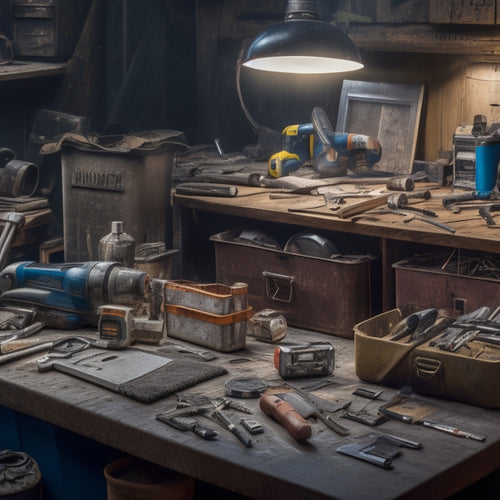
Top 3 Safety Essentials for DIY Renovations
Share
When tackling a DIY renovation, you'll want to prioritize three essential safety items to protect yourself from potential hazards. First, invest in protective gear like gloves and eye protection to shield yourself from cuts, abrasions, and chemical exposure. Next, guarantee safe ladder practices by maintaining three points of contact, regularly inspecting your ladder, and positioning it on a level surface. Finally, don't overlook respiratory protection - assess the airborne contaminants in your workspace and choose the right respirator for the job. By covering these bases, you'll be well-equipped to handle the tasks ahead and minimize risks.
Key Takeaways
- Wear protective gear, including gloves, safety glasses, and a respirator, to shield yourself from hazards like cuts, debris, and airborne contaminants.
- Ensure ladder stability by maintaining three points of contact, inspecting regularly, and cleaning the ladder before each use.
- Choose the right respirator type based on the specific workspace hazards and air quality to filter out harmful particles or provide a separate air supply.
- Select gloves that provide grip, dexterity, and chemical resistance to protect your hands from task-specific hazards.
- Always prioritize comfort and visibility when selecting safety eyewear to ensure a secure fit and clear vision.
Protective Gear for DIYers
When tackling a DIY renovation, you're likely to encounter a range of hazards that can put your health and safety at risk. One of the most essential safety requirements is protective gear.
You must prioritize your safety by selecting the right gloves for the task at hand. Gloves selection is important, as it can protect your hands from cuts, abrasions, and punctures. Choose gloves that provide grip, dexterity, and resistance to chemicals or abrasives, depending on the specific task.
Eye protection is another critical aspect of DIY renovation safety. You'll need to safeguard your eyes from debris, dust, and chemical splashes. Invest in high-quality safety glasses or goggles that provide 360-degree protection. Confirm they fit comfortably and have anti-fog coating to maintain clear visibility.
Safe Ladder Practices Matter
Ladders are an essential tool in DIY renovations, but they can also be a significant hazard if not used properly. You must guarantee ladder stability by always maintaining three points of contact, whether it's two hands and one foot or two feet and one hand. This will prevent slipping and falling, which can lead to serious injuries.
Regular ladder maintenance is vital to prevent accidents. You should inspect your ladder before each use, checking for worn or damaged rungs, loose rivets, and slippery surfaces.
Clean your ladder regularly to remove dirt, grease, or other substances that can compromise its stability. Additionally, make certain your ladder is securely positioned on a level, firm surface, and always maintain a secure handhold when climbing up or down.
Respiratory Protection Is Key
During demolition and renovation, you'll likely encounter airborne contaminants like dust, debris, and hazardous particles that can wreak havoc on your respiratory system. Inhaling these particles can lead to serious health issues, including respiratory diseases and even long-term damage.
It's vital to prioritize respiratory protection to guarantee your safety on the job site.
You'll need to choose the right respirator type for the task at hand. There are two primary categories: air-purifying respirators (APRs) and supplied-air respirators (SARs).
APRs filter out contaminants, while SARs provide a separate air supply.
When selecting a respirator, consider the specific hazards you'll face and the air quality in your workspace.
Frequently Asked Questions
What Licenses Do I Need for a DIY Renovation Project?
You'll need to determine which building permits and licenses are required for your DIY renovation project, as renovation regulations vary by region, and failing to comply can result in costly fines and project delays.
Can I Renovate During Pregnancy or With Young Children Nearby?
As you ponder renovating during pregnancy or with young children nearby, investigate the alarming truth: exposure to renovation toxins can harm fetal development and child health. You must prioritize pregnancy safety, taking precautions to minimize hazardous exposure.
How Do I Dispose of Hazardous Materials Safely?
You'll need to identify hazardous materials, segregate them from regular trash, and follow local safety guidelines for hazardous waste disposal, ensuring you're equipped with the necessary protective gear and adhering to strict handling procedures to prevent accidents.
Do I Need to Hire a Professional for Electrical Work?
Are you willing to risk your life to save a few bucks on electrical work? You shouldn't, as you're not an expert in safety precautions and electrical codes - hire a licensed pro to guarantee a safe and compliant renovation.
Can I Reuse Old Materials in My DIY Renovation Project?
You're considering reusing old materials in your DIY renovation project, but before doing so, you must carefully assess their condition, ensuring they're structurally sound and compliant with building codes, then strategically source materials that align with your project's requirements.
Conclusion
As you initiate your DIY renovation journey, remember that safety is the unsung hero that keeps you standing tall amidst the chaos. Don't let the dust settle on your well-being - gear up with the right protective equipment, ladder practices that are rock-solid, and respiratory protection that's a refreshing change. With these essentials in your toolkit, you'll be fortified against the unseen dangers that lurk in every demolition zone, and your project will be a masterpiece that's built to last.
Related Posts
-

Smart Guide to Buying Second-Hand Renovation Tools
When buying second-hand renovation tools, you'll want to set clear renovation goals and a realistic budget to priorit...
-

3 Best DIY Home Renovation Timelines for Success
As you tackle your DIY home renovation project, create a solid timeline by breaking it down into three phases. First,...
-

Stucco Patching Material Checklist for Home Renovation
You'll need a range of essential tools, including a putty knife, wire brush, hawk or flat trowel, level, and straight...


